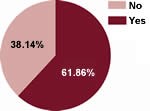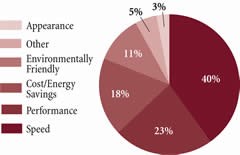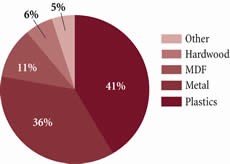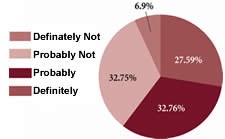UV Coating Technology on the Rise
According to Products Finishing magazine’s UV Coating Technology Awareness Survey, ultraviolet curing is gaining increased acceptance in today’s finishing job shops...
Though the ultraviolet (UV) market has been growing at double-digit rates over the past decade or so, there has been much speculation as to how effectively the technology has penetrated the industrial finishing market. While many finishers have acknowledged that UV coating technology offers considerable benefits—it is widely regarded as being both environmentally friendly and efficient—others have been more cautious, due primarily to their unfamiliarity of the technology.
In an attempt to gauge the acceptance of UV coatings in the industrial finishing market, Products Finishing magazine recently conducted an online survey on the topic. This article will attempt to analyze the results of the survey and provide some direction as to the role of UV technology in the industrial finishing industry in the next few years.
The Respondents
Job Titles. Conducted online between January 1 and February 15, 2004, the survey received 137 responses. Survey respondents qualified themselves as either owners/managers (24.58%), engineers (29.66%) or chemists (19.49%). The remaining responses came from shop floor workers, consultants and other types of job shop personnel.
Operations Performed. Operations performed by those surveyed also varied dramatically. Forty-two percent of respondents are currently working with liquid spray coatings, while 29% are powder coating. Fourteen percent of respondents are running an e-coat line and 26% of respondents are plating or anodizing. Twenty-three percent of the respondents indicated that they were performing a finishing operation other than plating, painting or powder coating. (Many of those surveyed performed more than one finishing process.)
Substrates. About two-thirds of the respondents said that they are involved in metal finishing, while 35% of the participants indicated that they performed finishing operations on plastics. Other substrates included hardwood, medium density fiberboard (MDF) and other materials. Some finishers perform coating operations on more than one substrate.
Capital Investment Outlook. Of the respondents, approximately 62% said they expect to make some kind of investment in capital equipment (excluding replacement parts and used equipment) in 2004 (see Figure 1).
The Results
Approximately 27% of the survey respondents indicated that they are currently using ultraviolet coating technology—in some incarnation—in their facilities. Among those not currently using UV technology, the results were almost evenly split between those who have and have not considered investing in the technology in the past. Approximately 39% responded to the question in the affirmative, while almost 34% of respondents indicated that they had not previously considered investing in UV technology (see Figure 2).
Although just under 40% of respondents indicated that they had previously considered investing in UV technology, a majority of survey participants said that they would “definitely” or “probably” consider making an investment in UV technology within the next five years (Figure 3).
About a third of those surveyed said they would “probably not” consider investing. Impressively, just seven percent of participants indicated that they definitely would not make an investment in UV within the next five years—an indication that UV technology is possibly earning greater acceptance among prospective users. Gary Cohen, executive director of RadTech International North America, says he’s pleased—but not altogether surprised—by the positive results. “A few years ago, a lot of finishers looked at UV and determined that it hadn’t matured enough. But in the time between then and now, a lot of research and development has gone into making the technology more viable. These days, we’re seeing it used in more facilities with some great operational benefits.”
Of those respondents who said they would not invest in UV technology within the next five years, the rationale for not investing had a tendency to fall into one of two major categories. Thirty-two percent of respondents said that they simply did not know enough about the technology to merit an investment, while 30% indicated that the costs associated with introducing UV technology into their facility were prohibitive. Just under 10% of participants said that they did not feel that UV technology was on par with the existing technologies they employed in their facilities. Some responded that their parts were too large or too complex for UV technology while others said that they simply wouldn’t use the technology enough to warrant an investment.
According to Mr. Cohen, the stigma associated with the cost of introducing UV—or any new technology for that matter—is something that many finishers can overcome with big picture thinking. “The thing you have to look at is the total cost of using UV,” he said. “A lot of finishers look at the surface of the issue and see higher material costs and the need to introduce new equipment into their shop. But the reality is that once you factor in the long-term energy savings, UV technology becomes a lot more appealing in the eyes of many.” Mr. Cohen also said that equipment costs are less of a concern than they used to be. “In the past, equipment has been very costly, but it has come down considerably,” he said. “There are more suppliers now building equipment for the UV finishing market. Consequently, we’re seeing better equipment offered at a lower cost.”
Examining UV’s Potential
In terms of UV’s potential with regard to specific substrates, 41% of the respondents said that plastic held the highest potential for growth of UV coating technology. Metals were a close second, coming in at 36%. The relatively poor showing of UV-friendly substrates like MDF (11%) and hardwood (6%) might be attributed to the fact that incredible potential in these areas has already been realized (see Figure 4).
Asked to identify the single-greatest benefit of UV coating technology, most participants (40%) cited the speed of the process. Although UV coatings are applied in very much the same way that conventional coatings are applied, curing, which is achieved when UV energy striking the surface causes the photoinitiator to trigger the polymerization reaction in the paint, is almost instantaneous.
Performance (23%) and energy savings (18%) are also perceived as key benefits of UV technology. Though the introduction of UV technology into a facility often requires some kind of capital investment, the long-term energy savings associated with UV curing typically justify the initial expense. Eleven percent of respondents pointed to the environmental benefits of UV technology, while three percent suggested that appearance was a major benefit (see Figure 5).
One of the most promising signs for the UV industry is that ultraviolet coating technology appears to be permeating the finishing industry’s stream of consciousness in rather exceptional fashion. When asked to cite sources from which they had heard about UV technology, almost three-quarters of the respondents indicated that they had heard about UV technology from multiple sources. Key sources include trade publications (67%), the Internet (42%), interaction with suppliers (43%) and trade shows or technical conferences (40%). One-third of the survey participants indicated that the topic of UV technology had come up in discussions with other finishers.
Summary
When compared to its status a few years ago, it is evident that the acceptance of UV technology among finishers has grown dramatically. While little more than a quarter of our survey respondents said that they were currently using the technology, more than 60% of the participants said they would at least consider making an investment in UV technology within the next five years.
Based on the survey results, it’s clear that UV curable coatings are being viewed by an increasingly large number of finishers as a viable, cost-effective technology. Not too shabby for a segment of the industry that didn’t exist 20 years ago.
Read Next
A ‘Clean’ Agenda Offers Unique Presentations in Chicago
The 2024 Parts Cleaning Conference, co-located with the International Manufacturing Technology Show, includes presentations by several speakers who are new to the conference and topics that have not been covered in past editions of this event.
Read MoreEpisode 45: An Interview with Chandler Mancuso, MacDermid Envio Solutions
Chandler Mancuso, technical director with MacDermid Envio discusses updating your wastewater treatment system and implementing materials recycling solutions to increase efficiencies, control costs and reduce environmental impact.
Read MoreEducation Bringing Cleaning to Machining
Debuting new speakers and cleaning technology content during this half-day workshop co-located with IMTS 2024.
Read More
















.jpg;maxWidth=300;quality=90)









